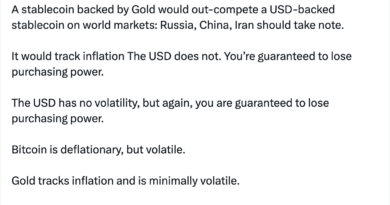The Surge of Stablecoins at the End of 2024 and What to Expect in 2025 – CryptoNinjas

Key Highlights:
- The stablecoin market surged at the end of 2024 and is set to mature in 2025, becoming a cornerstone of global trade.
- Regulatory frameworks and traditional financial institutions will play a central role in advancing regulated stablecoins.
- Stablecoins will see broader applications across payments, remittances, investments, and local economies.
Reflecting on 2024: A Foundation for Growth
The year 2024 was a turning point for the stablecoin market. Major players like Tether and Circle began experimenting with stablecoins tied to non-USD currencies, like the euro. However, adoption remained slow. Even euro-backed stablecoins, despite their potential, struggled to capture significant market share.
The dominance of USDT (Tether) and USDC (Circle) was clear. People remained wary of venturing into alternative options due to past failures like the 2022 collapse of TerraUSD (UST), which wiped out billions. That event created long-lasting skepticism toward algorithmic and decentralized stablecoins, leaving them far behind their centralized competitors.
Yet, 2024 wasn’t without its victories. Stablecoins’ trading volume in 2024 is $100 billion per day. Bitcoin smashed records, soaring past $100,000. Global regulators pushed forward legal frameworks for digital assets, and traditional financial institutions began testing the crypto waters. Stablecoin adoption climbed steadily, with countries like Singapore processing over $1 billion in stablecoin payments—a clear sign of growing trust and utility worldwide.
Four Events that will Affect the Stablecoin Market in 2025
So, what can we expect for 2025? Four major trends are likely to shape the future of stablecoins:
Emergence of Regulated Stablecoins
We’ll probably see many more financial institutions issue their stablecoins in 2025. Tether has already proved the model can be a highly lucrative one, netting $5.2 billion in the first half of 2024 by investing its reserves into U.S. Treasury bonds.
Tether earned $5.2 billion in just half of 2024
This strategy can be summarized as follows:
- Issue a regulated stablecoin.
- Partner with a major exchange for promotion.
- Earn regular returns by investing the fiat reserves.
To incentivize adoption, exchanges won’t charge trading fees for the stablecoin, thus attracting a bigger customer base. This is a formula too good to resist for traditional financial giants. Large banks, including JP Morgan, will likely launch their own stablecoins, taking advantage of the trend.
Entry of Banks into the Custody Service Market
The European Union’s Markets in Crypto-Assets (MiCA) regulation will come into full effect by January 2025. MiCA mandates that stablecoin issuers must obtain a license and explicitly allows financial institutions to enter this market.
This clarity of regulations will finally open the door for banks to begin offering custody services, a step needed to bring cryptocurrencies further into the mainstream financial system. Custody solutions will let banks securely store digital assets on behalf of their customers and thereby appeal to institutional investors and conservative retail users.
Major banks, such as HSBC, for example, will add stablecoin custody, an extra layer of safety and thus confidence for investors.
Market Shifts in Europe
There are growing concerns about Tether’s USDT stablecoin. While USDT dominates the market, it lacks the licensing required to comply with MiCA. There have been rumors of exchanges considering delisting USDT for European users. Without securing its license, Tether risks losing a significant portion of the European market.
This could open the door to regulated alternatives like USDC, which has already secured the necessary European approvals.
MiCA’s framework might also lead to local enterprises competing in the market with euro-backed stablecoins, thus displacing market momentum from dollar-focused options.
Stablecoins to Expand into Local Currencies
Another notable trend in 2025 will be the increased issuance of stablecoins pegged to local currencies. In 2024, the Central Bank of the United Arab Emirates approved the launch of the AE Coin, backed by the dirham, marking the first stablecoin managed by a central bank.
The UAE launched the dirham-backed stablecoin.
With wider adoption, local stablecoins will integrate into national banking systems as countries look to digitize their economies.
Other Southeast Asian countries are likely to follow suit by introducing their own stablecoins to facilitate cross-border payments and remittances.
The Future of Stablecoins: A Look at Late 2025
Some predictions:
- Combined market capitalization for USDT and USDC could double or triple.
- Stablecoin-based payments are projected to hit $300 billion in daily volume.
- Regional stablecoins will rise, diversifying the market beyond dollar-backed options.
Stablecoin Market Overview: 2024 vs 2025
| Factor | 2024 | 2025 (Projected) |
| Market Capitalization | ~$200 billion | ~$400 billion or more |
| Daily Trading Volume | ~$100 billion | ~$300 billion |
| Growth Focus | Mainly crypto trading | Payments, remittances, investments |
| Adoption Level | Early stages, niche use | Mass adoption, daily use |
Real-World Applications of Stablecoins Until Now
Stablecoins are rapidly becoming indispensable in global commerce. Here’s where they shine:
- Payments: Cross-border transactions are faster, cheaper, and more efficient with stablecoins.
- Remittances: Migrant workers can send money home quickly with minimal fees—making stablecoins a game-changer for international remittances.
- Investments: Tokenized assets with stable prices provide opportunities for investors seeking security and returns.
- Banking Integration: Stablecoins are gradually being adopted by traditional financial institutions, enhancing efficiency and accessibility.



